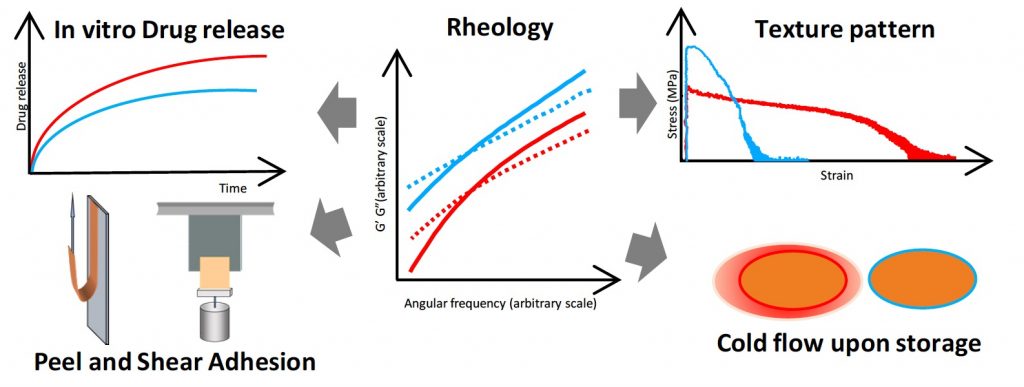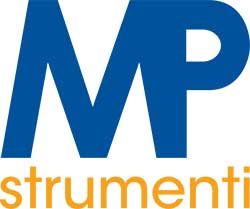- La caratterizzazione reologica nello sviluppo di un cerotto transdermico

Sommario I cerotti transdermici sono forme farmaceutiche adesive a rilascio prolungato destinate ad essere applicate sulla pelle. Per assicurare il corretto assorbimento del principio attivo devono permetterne il rilascio ed aderire alla pelle per l’intera durata del trattamento. Infatti, se il cerotto si solleva o si stacca parzialmente, l’assorbimento del principio attivo è ridotto e il trattamento può risultare inefficace. Inoltre, la stabilità fisica del principio attivo nella matrice adesiva è spesso critica dal momento che la preparazione del cerotto porta a un sistema soprassaturo in cui il principio attivo può cristallizzare durante il periodo di conservazione con la conseguenza di compromettere il suo rilascio. Il componente principale della matrice adesiva è il pressure sensitive adhesive che aderisce alla pelle esercitando una leggera pressione ed è rimosso da questa senza lasciare alcun residuo. Si tratta di un materiale viscoelastico in grado di formare legami reversibili con il substrato e altamente dissipativi in fase di distacco. Le proprietà reologiche e di superficie della matrice adesiva sono pertanto i principali fattori che determinano le proprietà adesive del cerotto (appiccicosità, resistenza al distacco e allo scorrimento, cold flow) e la loro influenza è stata ampiamente discussa. Al contrario, l’impatto delle proprietà viscoelastiche sul rilascio del principio attivo in vitro, sul suo assorbimento in vivo, così come su una sua eventuale cinetica di ricristallizzazione, non è stato sufficientemente studiato.
Al fine di approfondire questi aspetti sono stati effettuati alcuni studi utilizzando come materiali adesivi (i) un poliammonio metacrilato (Eudragit RL, Evonik, EuRL) plasticizzato con tributil citrato (TBC) o triacetina (TRI) e (ii) un copolimero a blocchi Stirene-Etilene-Butilene-Stirene (SEBS) adiuvato con olio di vaselina e una resina alifatica.
Nel caso di EuRL, l’aggiunta del 40-60% m/m di TBC o del 40-50% m/m di TRI ha permesso di ottenere matrici con le proprietà adesive desiderate. È stata, inoltre, verificata la dipendenza delle proprietà adesive dal tempo di rilassamento (tR) della matrice. Le prestazioni del cerotto sono state valutate determinando la cinetica di rilascio e di permeazione attraverso epidermide umana utilizzando flurbiprofene, ketoprofene e ibuprofene come molecole modello. Le costanti di velocità di rilascio (k) determinate mediante saggio di dissoluzione sono risultate dipendenti da tR: maggiore è la fluidità della matrice, maggiore la velocità di rilascio. Lo stesso andamento è stato evidenziato nel caso di matrici adesive a base di SEBS, sottolineando l’utilità di uno studio approfondito delle caratteristiche reologiche per ottimizzare la formulazione non solo per garantire le proprietà adesive, ma anche il corretto rilascio del principio attivo.
Parole chiave proprietà adesive, rilascio del principio attivo, reologia.
Abstract Transdermal patches and medicated plasters are pharmaceutical preparations designed to provide a prolonged delivery of drugs to the skin and achieve a systemic or local effect, respectively. Usually, they are drug-in-adhesive systems, in which the drug is dispersed and/or dissolved in a pressure-sensitive adhesive (PSA) matrix. PSAs are defined as soft polymeric materials that display an instantaneous adhesion on almost any surface by simple contact under a light pressure and that can ideally be detached from the substrate without residues.
The efficiency of the therapeutic treatment by these dosage forms is related not only to their ability to release the drug, but also to their complete skin contact on the whole delivery surface for the entire treatment period. If the patch lifts or partially detaches, the effective contact area, and thus the drug absorption, is unpredictable and a therapeutic failure can occur. Moreover, the physical stability of the drug in the PSA is critical since the preparation of the patch can lead to a supersaturated system in which the drug can crystallize during the storage and consequently its release and the following skin absorption can be compromised. All these properties are strictly related to the rheological pattern of the PSA.
It is well recognized that the adhesive properties of PSAs strongly depend on their viscoelastic characteristics. Viscoelastic materials are needed in order to relax stresses, easily create a molecular contact, and dissipate energy upon debonding. Indeed, PSAs should be soft and relax stresses to favor the contact with the substrate, but they should also be highly dissipative (lightly physically or chemically crosslinked) to resist to the applied tangential stresses due to the body movement once the bond is formed. From a technological point of view, the PSA matrix is characterized by tack, peel adhesion and shear adhesion. Their dependence on both in bulk rheological properties and interfacial forces have been widely debated. Conversely, the impact of the viscoelastic properties of the PSA on the in vitro drug release and in vivo drug absorption are not deeply investigated. In the same way, few information is available on the impact of the viscoelasticity of the matrix on the kinetic of re-crystallization of the loaded drug.
The research focused on the possible use of a poly(ammonium methacrylate) (Eudragit RL, Evonik, EuRL) plasticized by tributyl citrate (TBC) or triacetin (TRI) evidenced the relationship among the pharmaceutical technological properties and rheological pattern. The patch adhesion properties (i.e. tack, peel and shear adhesion) as well as in vitro biopharmaceutical performances were determined after drug loading. The addition of 40-60% w/w TBC or 40-50% w/w TRI to EuRL permitted to obtain matrices with the desired tack, peel adhesion and shear adhesion properties. The increase of plasticizer content and the drug loading reduced the relaxation time (tR). Consequently, the shear adhesion values decreased and the in vitro drug release constants (k) of ibuprofen, ketoprofen or flurbiprofen, selected as model drugs, increased. Indeed, the k values from patches containing TBC were lower than the corresponding with TRI because of the lower fluidity of such matrices. The same dependence of the drug release by the matrix fluidity was found also in the case of Styrene-Ethylene-Butylene-Styrene, SEBS, based pressure sensitive adhesive, underlining the usefulness of a deep characterization of rheological properties to optimize not only the adhesive properties of a transdermal patch, but also the drug release.
Keywords pressure sensitive adhesive, texture analyses, drug release, rheology













